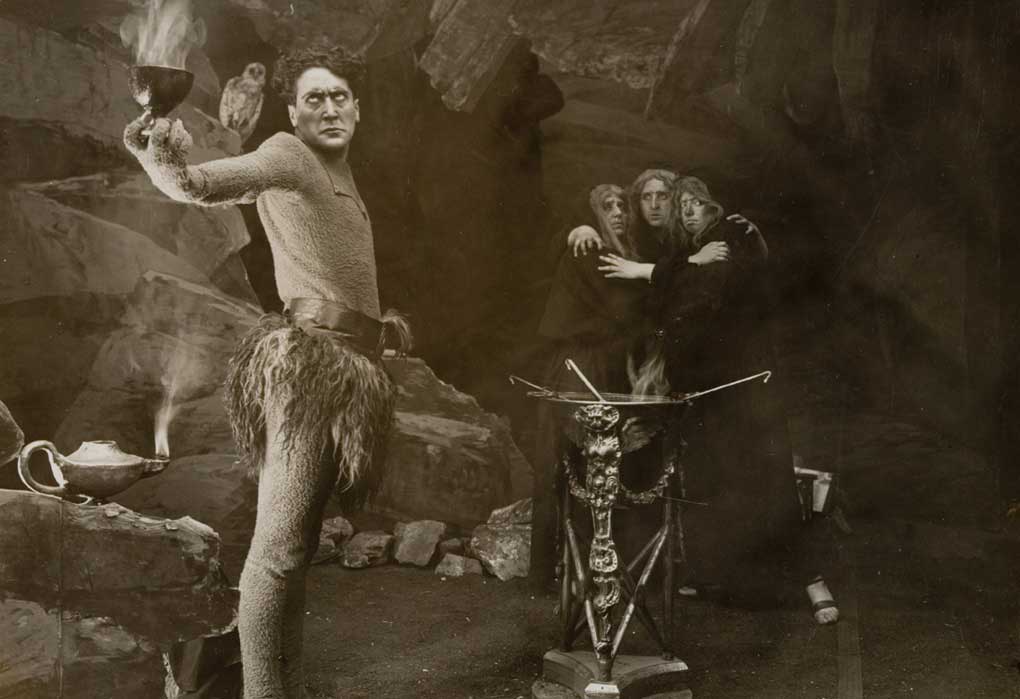SATANA
(Satan)
Luigi Maggi (IT 1912)
1912 was a crucial year for Mario Bonnard. He was beginning to show a surer ability for interpreting a range of roles, and developing a more refined awareness in his character portrayals. Time spent in the Caserini “school” and working in a such a wide-ranging and varied company as Ambrosio were bearing fruit. Bonnard was maturing as an actor, and it is in the role of Satan that his skill was first revealed. We can only guess the impact the film had on audiences at the time, since all that is viewable today is an 8-minute fragment conserved in the BFI National Archive, showing Satan at Christ’s Baptism and Passion. In her Storia del cinema muto italiano Maria Adriana Prolo observes that the representation of “diverse manifestations of a single force in various epochs” in Satana coincided with the subsequent American production Intolerance.
Originally in two parts, Il gran ribelle (The Great Rebel) and Il distruttore (The Destroyer), and four acts, Satana narrates the dramma dell’umanità (The Drama of Humanity, which is also the film’s subtitle). In Il gran ribelle Satan is depicted fighting against good and justice, a struggle he will lose. The first act, Satana contro il Creatore (Satan versus the Creator), draws on Milton’s Paradise Lost; Satan descends to Earth after a bitter struggle with God. The second act, Satana contro il Salvatore (Satan versus the Saviour), based on another epic poem, Friedrich Gottlieb Klopstock’s Der Messias (The Messiah), sees Satan in Jerusalem in the guise of a Pharisee, determined to pick a fight with Jesus (played by Mario Voller Buzzi).
In the second part, Il distruttore, Satan fights Man, and this time he is victorious. The first act, entitled Il Demone verde ossia Satana nel Medioevo (The Green Demon, or Satan in the Middle Ages), features Gerberto, an alchemist at a monastery who is corrupted by Satan, who helps him to create absinthe, and then drinks to the success of his efforts. The second act, Il Demone rosso ossia Satana nella vita moderna (The Red Demon, or Satan in Modern Life), is set in an early 20th-century engineering works, where Satan destroys the love between Maria and Furio (Fernanda Negri-Pouget and Enrico Lupi) and ruins the business, bringing death and destruction.
All that is left of this long and complicated work are a few scenes, but light can be shed on them by the photographs and publicity material now in the Museo del Cinema in Turin. How can anyone not be amazed and enthralled by the contorted poses of the young Bonnard? His body assumes metaphysical traits while his face becomes fatally diabolical with make-up that accentuates his cheekbones and eyes. How can one not be enchanted by the dreamlike sets, which create unheard-of spaces? Fresh from the success of Il granatiere Roland (Grenadier Roland) and Nozze d’oro (After Fifty Years), both 1911, with Satana director Luigi Maggi regaled audiences with a great moral journey through greed, corruption, and violence – all in a total length of 1,960 metres, for Ambrosio’s “Serie d’Oro” (“Gold Series”). Some sources credit Arturo Ambrosio as co-director.
The film was also a great success abroad; it is known to have been distributed, in various lengths, in the United States, France, Britain, Sweden, and Hungary. One page of the brochure devoted to the film reads: “The origins of all humanity’s faults and tragedies are to be found in this drama, and the spectator’s heart is naturally carried to a final moral: to detest Abomination, the Son of Darkness, and to aspire to Good, the Son of Light”.
Marcello Seregni

regia/dir: Luigi Maggi.
sogg/story: Guido Volante, dai poemi di/from poems by: John Milton (“Paradise Lost”, 1667); Friedrich Gottlieb Klopstock (“Der Messias”, 1773).
photog: Giovanni Vitrotti.
cast: Mario Bonnard (Satana/Satan), Mario Voller Buzzi (Gesù Cristo/Jesus Christ), Mary Cléo Tarlarini (la cortigiana/the courtesan Fiammetta), Fernanda Negri-Pouget (la fioraia/the flowergirl Maria), Enrico Lupi (Furio), Rina Albry, Vitale De Stefano, Oreste Grandi, Bianca Schinini, Cesare Zocchi, Ercole Vaser, Armando Pouget, Lia Negro, Giuseppina Ronco, Carlo Campogalliani.
prod: Ambrosio, Torino (Serie d’Oro – film n. 762).
uscita/rel: 10.12.1912.
v.c./censor date: 01.12.1913 (n. 134).
copia/copy: frammento/fragment, 35mm, 167 m. (orig. 1960 m.), 8′ (18 fps); did./titles: ENG.
fonte/source: BFI National Archive, London.


 Italiano
Italiano